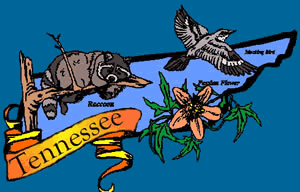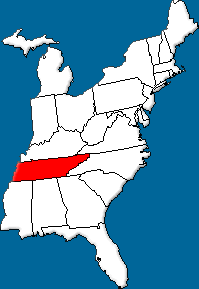 History:
British and French explorers both laid claim to the area now known as Tennessee in 1673. James Needham and Gabriel Arthur, English traders, crossed the Appalachian mountains from South Carolina hoping to establish trade with the Cherokee. From the west, Father Jacques Marquette and fur trader Louis Joliet came down the Mississippi River and claimed the entire river valley in the name of the King of France. Both the British and the French built forts and trading posts in attempts to solidify their claims to the land.
Independent fur traders also lived in the area. They served as an important link between native people, colonial governments and European markets. This profitable enterprise, in which traders hired native hunters to supply them with beaver skins and deer pelts, eventually wiped out much of Tennessee's native animal life. In 1748, merchants exported over 160,000 skins worth $250,000. This struggle for profit also increased the rivalry between the English and the French and drew native hunters into the conflict.
Eventually, the conflict became one of the causes for the French and Indian Wars. The defeat of the French in this war meant that their lands were ceded to the British. Although the British Proclamation of 1763 prohibited westward settlement beyond the Appalachians, the desire for land led restless Virginians and North Carolinians to move across the mountains into the valleys of East Tennessee. By the early 1770s, four different European communities were established and the possession of land took precedence over the establishment of trade in the new frontier.
The establishment of the United States independent from the British officially opened the land west of the Appalachians to further settlement, and in the winter and spring of 1779, a group of 300 pioneers, both black and white, established an outpost at French Lick, the eventual site of the town of Nashville.
Without an organized government however, settlers had little protection on the frontier, nor did they have any political voice. Six counties had originally been part of North Carolina between 1777 and 1788, but after the Revolution, North Carolina didn't want the trouble and expense of maintaining these distant settlements. In 1784, East Tennesseans established the State of Franklin and named John Sevier governor. The state was not recognized by the United States, and some leaders considered an alliance with Spain, which controlled the lower Mississippi River. Once North Carolina realized the danger of having a Spanish-sympathizing government so nearby, the state re-established its control over the area, and the State of Franklin dissolved in 1788. In 1789, North Carolina ratified the new Constitution of the United States and formally ceded its western counties to the Federal government. President George Washington appointed a territorial governor, but the central concern with land ownership and speculation continued to dominate. The early political leaders in Tennessee were also the state's biggest land speculators, and determining what land belonged to settlers and what land belonged to native tribes, and how land would be bought and sold was subject to great corruption.
By 1795, there was enough population for statehood, and a referendum indicated that the settlers wanted to join the Union. A constitutional convention met in Knoxville and on June 1, 1796, Congress approved the admission of Tennessee as the sixteenth sate of the Union.
The availability of cheap, fertile land meant settlement in Tennessee exploded. Along with increased settlement came the increase in the number of black slaves who had been brought along to farm the land. By 1810, blacks constituted over 20 percent of the population. Along with slaves, however, Tennessee was also home to a large number of free blacks because the state Constitution made it easy for owners to free slaves, and provided for relative social equality for free blacks. Unfortunately, the requirement for large numbers of slaves to work the land for a profit meant these early gains quickly disappeared.
By 1840, most of the Native Americans had been forced to leave Tennessee. Many traveled the "Trail of Tears" to what would later become Oklahoma. Tennessee grew quickly as settlers flocked to the state to grow cotton, tobacco and corn. Railroads expanded throughout the area.
Slavery divided the nation during the late 1850s. Several southern states seceded from the Union that led to the Civil War (1861-1865). After the war began, Tennessee became the last of eleven states to secede from the Union. More than 200 battles took place in Tennessee. The bloodiest of these was the Battle of Shiloh in 1862. Over 10,000 Confederates and 13,000 Union soldiers died when Confederate troops tried to stop Union soldiers from going into Mississippi.
The Confederacy surrendered on April 9, 1865, only days before the assassination of President Abraham Lincoln. Vice-president Andrew Johnson of Tennessee became President of the United States upon Lincoln's death. After some controversy, Tennessee was the first state to be readmitted to the Union in July 1866.
Reconstruction was a difficult period for Tennessee. Much of the state was destroyed and thousands were left unemployed and homeless. Plantation owners were forced to divide into smaller farms. Political unrest led to secret societies like the Ku Klux Klan.
In the twentieth century, Tennessee was back in the national spotlight with the celebrated trial of John T. Scopes, the so-called "Monkey Trial." In 1925, the legislature, as part of a general education bill, passed a law that forbade the teaching of evolution in the public schools. In Dayton, local residents asked Scopes, a high school biology teacher, to violate the law and stand trial as a way of drawing publicity and visitors to the town. Their plan worked all too well, and the county courthouse was turned into a circus of national and even international media coverage. Thousands flocked to Dayton to witness the high-powered legal counsel (William Jennings Bryan for the prosecution and Clarence Darrow for the defense, among others) argue their case. |










 The home of Andrew Jackson, this expansive cotton plantation centered by the imposing mansion was the place Jackson always loved best, a place where he was surrounded by family and welcomed friends and colleagues. In addition to original colors and exactly reproduced textiles, almost all of the furnishings, including furniture, silver, porcelains and portraits, belonged to Jackson. Many of his personal possessions are also here including a sword, hundreds of books, eyeglasses and Bible.
The home of Andrew Jackson, this expansive cotton plantation centered by the imposing mansion was the place Jackson always loved best, a place where he was surrounded by family and welcomed friends and colleagues. In addition to original colors and exactly reproduced textiles, almost all of the furnishings, including furniture, silver, porcelains and portraits, belonged to Jackson. Many of his personal possessions are also here including a sword, hundreds of books, eyeglasses and Bible.